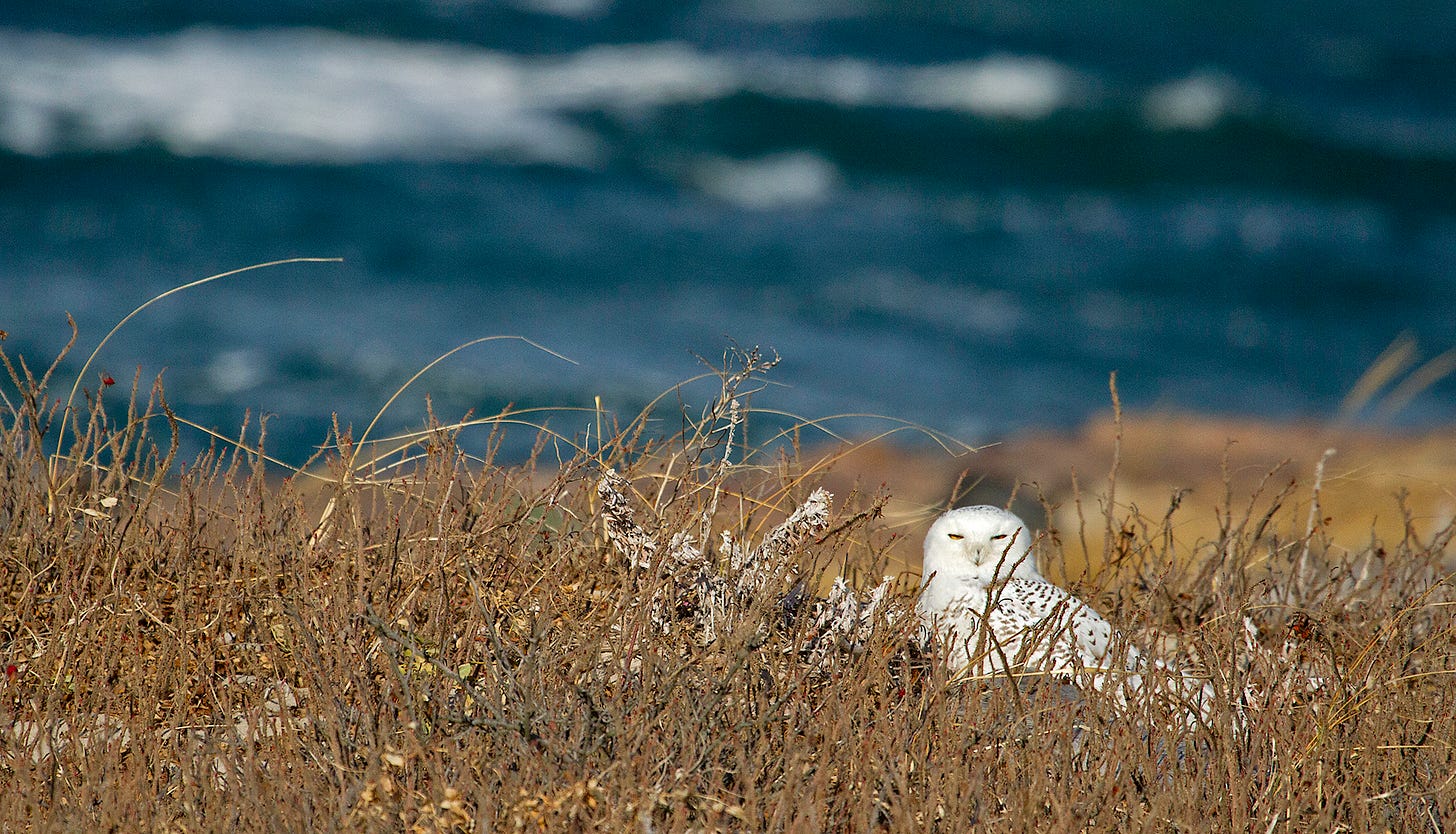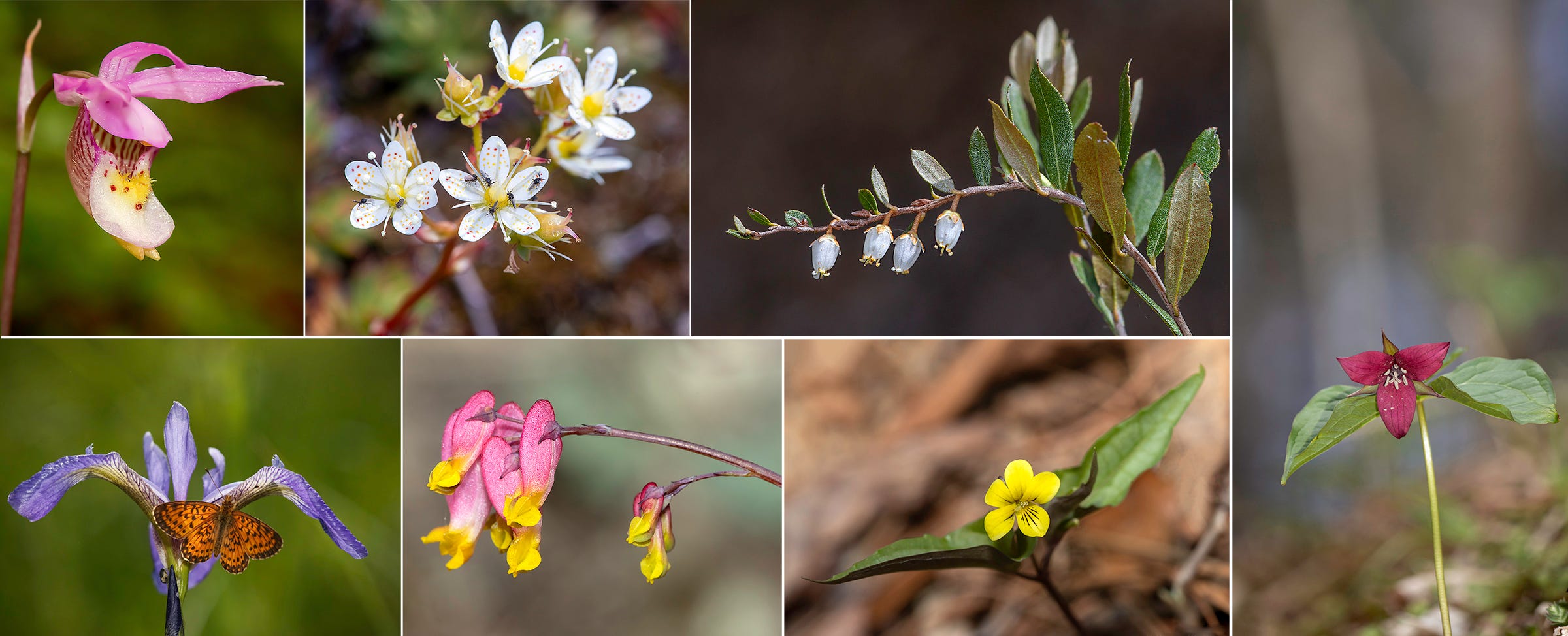Errors and Opportunities
My Omissions and Your Understanding of Owls and Liverwort Sperm
HERE’S A SENTENCE you don’t often see in print or online: I was wrong. (Or in the parlance of politics: Mistakes were made.) So today I launch an occasional feature on Chasing Nature designed to set right my errant explorations of wildlife, wild places, and the human condition.
From my flaws there shall be opportunity. Each correction or clarification will be a kind of reflection or expansion so that you and I might consider other wild ideas in the natural world. We begin with two items: Snowy Owls and iconoclastic thinking on liverwort sperm and plant reproduction in general. (By the way, as a form of respite from the flooding, ice storms, and polar weather of late here in North America, that’s a Ferruginous Pygmy-Owl, about the size of your coffee mug, looking me over from what was perhaps a cultivated Neem tree [Azadirachta indica] on a calm, warm day in the dry forest of Costa Rica in 2015.)
Snowy Suppression
In my essay Snowy Owls Are Coming for Us, published on November 16, 2023, I predicted the customary wintertime arrival of the white owls to southern Canada, the northern U.S., and (in small part) northern Europe. The owls did indeed come for us, by which I mean for our benefit, but not in their usual numbers, especially here in northeastern U.S., where it hasn’t been this sparse for Snowy Owls since the winter of 2010-2011.
In the past month or two, only a few Snowy Owls have turned up along the New England coast and points south (one reported on Long Island and another in Maryland). By contrast, a fair number of Snowy Owls now occupy a swath of territory roughly from southern Quebec and Ontario, through the Midwest to Alberta (with owls visiting Saskatchewan in huge numbers this winter). In Europe, well, maybe next year. So, technically, yes, the Snowy Owls have come for some of us, but not nearly as I had expected for most of us.
This does not necessarily mean something is wrong with the owls (although there is concern about their status on an overheating planet). The most likely explanation for their absence this winter would be a bust in Arctic lemming reproduction (Snowy Owl food), which can suppress breeding success. It’s usually those young-of-the-year owls that head south toward us.
The mild winter, owing in part to El Niño, may also be keeping the owls farther north. And Highly Pathogenic Avian Influenza (HPAI), or bird flu, has afflicted owls and other raptors. Scott Weidensaul, the author and ornithologist who co-founded Project SNOWstorm, which tags and tracks Snowy Owls, reports that “ … while we suspect this winter’s poor showing is more likely a normal dip in the periodic boom and bust, we can’t be certain avian flu isn’t exacerbating it.”
In any event, I’ll continue on the Snowy Owl watch for you, providing updates for paying subscribers at GO WILD.
Sperm Semantics and the Flower Binary
It looks like sperm, swims like sperm, acts like sperm, but strictly speaking: Is it sperm? We’re of course talking about a liverwort’s motile gamete — a term I did not use in my essay A New Year and an Ancient Plant, published on January 1, 2024. Since then my thinking on that post has sent me back to Linnaeus and ahead to contemplations of biological sex and the ways we describe it in plants.
My discussion here has nothing to do with cultural and political discourse on sex and gender — at least not yet. Neither a botanist nor a social scientist, I’m still not sure how I feel about what follows, which was until now uncharted terrain for me. So my ideas are strictly ecological, concerned with the biology of plant reproduction rather than the dynamics of sexuality in humans. At the very least I’m offering another way of thinking about plants and our place among them. So buckle up.
First recall that most liverwort species are dioecious, which means that a given liverwort plant out there in the world is either male (producing what lots of botanists call sperm) or female (producing what botanists call eggs). The sperm (they have two flagella) swim on a film of water in their journey to fertilize the eggs of a separate female liverwort plant.
It is convenient parlance — male and female, sperm and egg — a likening of plant reproduction to that of human and non-human animals. And yet the comparison is problematic. It obscures a monumental event in the history of life, actually two monumental events: the separate and unequal evolution of reproduction in plants and animals. More provocatively, in casting plant procreation in the image of humans (and perhaps even the patriarchy), which dates at least to Linnaeus, our lexicon and the male-female binary detracts from plants’ own creative, beautiful, ruthless, fluid, and magnificent ways of reproduction. In ecological respects, plant sex is far more versatile and interesting than human sex.
Setting aside liverworts and their sperm for the moment, the vast majority of flowering plants — largely the plants of our lives, called angiosperms (there we go again with sperm) — are neither male nor female (to use standard parlance). They are bisexual. Each of their flowers contain both male and female reproductive parts: stamens (producing pollen) and pistils (with an ovary).
With more than 300,000 flowering plant species in the world, their reproductive strategies are nothing if not varied and fantastic. Depending on the species, flowers can breed with themselves or (more often) with other flowers of their species. Among some of the species that are indeed binary, either male or female, their flowers can be fluid, changing their sex (flower types) from year to year. (See the Postscripts.)
Flowers employ wind and rain and fire to help in their reproduction, to say nothing of birds and bees and mammals (including humans). And in their cavorting with other kingdoms, particularly insect pollinators, flowers have evolved some of the most wonderful and ornate colors and patterns on earth. These beautiful complexities lure insect partners and please humans to no end, except the flowers that glow for insects in ultra-violet wavelengths of light that we cannot see. Flowers can beckon pollinators (and us) by way of nectar and fragrance or by appearing and smelling like rotting flesh.
My point here is that flowers are so much more than male or female. Like us, they are nature and culture — their very own nature and culture (Subramaniam 2023).
Which brings me back to those ancient liverworts and their sperm. Apart from form and function, and despite our lexicon, liverwort sperm and human sperm have nothing in common. By which I mean a common ancestor that reproduced by way of sperm. Instead, sperm is apparently such a good enough “idea” that it evolved independently in plants and in animals. Early land plants were probably reproducing by way of motile gametes and fixed gametes about a half-billion years before we came along to name them sperm and eggs among male and female plants and their parts (Higo 2018).
We Homo sapiens are but a minuscule bud on a tiny twig of a gigantic tree of life. Out on a limb, we are so full of creativity and intelligence, so full of love and promise, and yet so full of ourselves; we are alone as the sole remaining occupant of our genus (perhaps more aptly named Homo hubris). And so we get to name things however it damn well suits us.
I do, however, like it that our linguistics share words and culture with nature. Trees and humans have limbs and roots. Some of us are shrinking violets and wallflowers. We can be lost in the weeds or found blossoming. So for now at least, I’m okay with liverwort “sperm and eggs,” which as it turns out botanists (no shrinking violets when it comes to scientific terminology) sometimes call antherozoids and oospheres.
At the end of the day, and literally among them outside, I will continue referring to insects and birds as male or female. And even if I do the same with plants and their reproductive parts, I will always think much more highly of them and their varied ways reproduction. Far more than male or female, more than boy meets girl, even more than a meeting of their gametes, plants are a kingdom of their own magnificent sexuality.
Postscripts and Acknowledgments
I wonder if our long cultural and botanically invalid linking of flowers to femininity and fertility might render as sexist the terms wallflower and shrinking violet. I’m honestly not sure. Your thoughts in comments?
I reported on fluidity in maple flowers in a post last February titled Red Alert. It won’t be long before the Red Maples are flowering at southern latitudes here in the U.S.
Finally, and most importantly, beyond my own growing exuberance for botany, my prompts and a few ideas for this post came first from ornithologist and evolutionary biologist Richard Prum (who reminded me that plant and animal sperm are not homologous and who explained his new ideas and book on the sexual binary in an Aeon essay last week). I also drew inspiration from (but barely scratched the surface of) a lengthy essay in the journal Integrative and Comparative Biology by Banu Subramaniam and Madelaine Bartlett. Botanists Liz Thompson and Jill Weber are wise and trusted manuscript reviewers.
References
Fisher, H.S., Roldan, E.R.S., Avidor-Reiss, T., and Rowe, M. (2023). On the Origin and Evolution of Sperm Cells. Cells 12, 159. https://doi.org/10.3390/cells12010159
Haig D. (2016). Living together and living apart: the sexual lives of bryophytes. Phil. Trans. R. Soc. B 371: 20150535. http://dx.doi.org/10.1098/rstb.2015.0535
Higo, A., Kawashima, T., Borg, M. et al. (2018). Transcription factor DUO1 generated by neo-functionalization is associated with evolution of sperm differentiation in plants. Nature Communications 9, 5283 (2018). https://doi.org/10.1038/s41467-018-07728-3
Subramaniam, B. and Bartlett, M. (2023). Re-imagining Reproduction: The Queer Possibilities of Plants. Integrative and Comparative Biology, Volume 63, Issue 4, October 2023, 946–959. https://doi.org/10.1093/icb/icad012






Brian, you have brilliantly provided the quote of the year. Thank you for all your writing.
"We Homo sapiens are but a minuscule bud on a tiny twig of a gigantic tree of life. Out on a limb, we are so full of creativity and intelligence, so full of love and promise, and yet so full of ourselves; we are alone as the sole remaining occupant of our genus (perhaps more aptly named Homo hubris). And so we get to name things however it damn well suits us. "
Every essay, besides making me think, contains at least one “Bryanism” that makes me laugh knowing it made you laugh when you thought of it and wrote it. This time it was the sentence that began “Out on a limb..”. You are so skilled in taking us, your readers, along on your rambles in the woods or in your mind. I do miss your “in person” field trips. This is the next best thing.
I remember loving to take my biology students into the woods and stopping in a mossy glen. Inviting them to take off their shoes and sox to enjoy the green carpet, I’d segue into moss sex and sperm swimming on that same carpet after a rain. Most moved off into leaf litter taking their chances with slime molds.